Vera Axelrod
Multimodal Modeling For Spoken Language Identification
Sep 19, 2023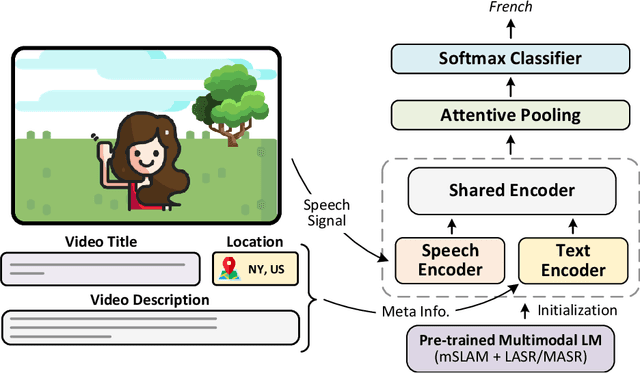

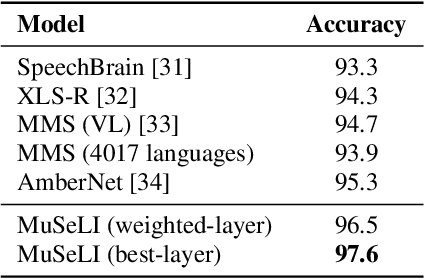
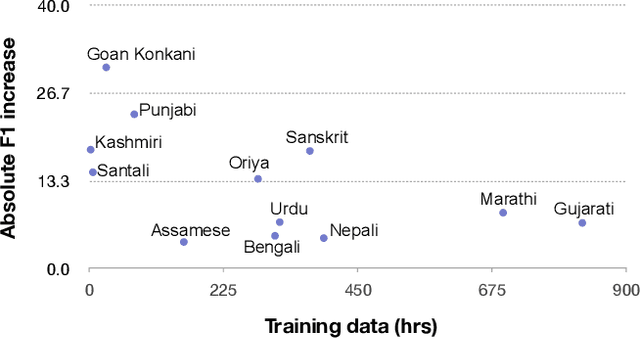
Abstract:Spoken language identification refers to the task of automatically predicting the spoken language in a given utterance. Conventionally, it is modeled as a speech-based language identification task. Prior techniques have been constrained to a single modality; however in the case of video data there is a wealth of other metadata that may be beneficial for this task. In this work, we propose MuSeLI, a Multimodal Spoken Language Identification method, which delves into the use of various metadata sources to enhance language identification. Our study reveals that metadata such as video title, description and geographic location provide substantial information to identify the spoken language of the multimedia recording. We conduct experiments using two diverse public datasets of YouTube videos, and obtain state-of-the-art results on the language identification task. We additionally conduct an ablation study that describes the distinct contribution of each modality for language recognition.
Label Aware Speech Representation Learning For Language Identification
Jun 07, 2023

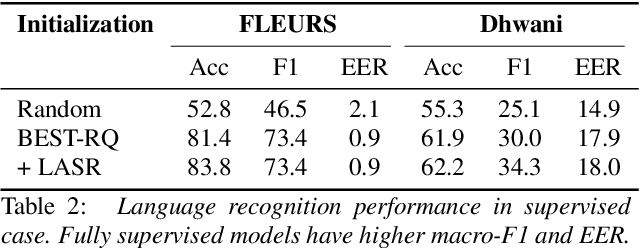

Abstract:Speech representation learning approaches for non-semantic tasks such as language recognition have either explored supervised embedding extraction methods using a classifier model or self-supervised representation learning approaches using raw data. In this paper, we propose a novel framework of combining self-supervised representation learning with the language label information for the pre-training task. This framework, termed as Label Aware Speech Representation (LASR) learning, uses a triplet based objective function to incorporate language labels along with the self-supervised loss function. The speech representations are further fine-tuned for the downstream task. The language recognition experiments are performed on two public datasets - FLEURS and Dhwani. In these experiments, we illustrate that the proposed LASR framework improves over the state-of-the-art systems on language identification. We also report an analysis of the robustness of LASR approach to noisy/missing labels as well as its application to multi-lingual speech recognition tasks.
XTREME-UP: A User-Centric Scarce-Data Benchmark for Under-Represented Languages
May 24, 2023



Abstract:Data scarcity is a crucial issue for the development of highly multilingual NLP systems. Yet for many under-represented languages (ULs) -- languages for which NLP re-search is particularly far behind in meeting user needs -- it is feasible to annotate small amounts of data. Motivated by this, we propose XTREME-UP, a benchmark defined by: its focus on the scarce-data scenario rather than zero-shot; its focus on user-centric tasks -- tasks with broad adoption by speakers of high-resource languages; and its focus on under-represented languages where this scarce-data scenario tends to be most realistic. XTREME-UP evaluates the capabilities of language models across 88 under-represented languages over 9 key user-centric technologies including ASR, OCR, MT, and information access tasks that are of general utility. We create new datasets for OCR, autocomplete, semantic parsing, and transliteration, and build on and refine existing datasets for other tasks. XTREME-UP provides methodology for evaluating many modeling scenarios including text-only, multi-modal (vision, audio, and text),supervised parameter tuning, and in-context learning. We evaluate commonly used models on the benchmark. We release all code and scripts to train and evaluate models
Google USM: Scaling Automatic Speech Recognition Beyond 100 Languages
Mar 03, 2023Abstract:We introduce the Universal Speech Model (USM), a single large model that performs automatic speech recognition (ASR) across 100+ languages. This is achieved by pre-training the encoder of the model on a large unlabeled multilingual dataset of 12 million (M) hours spanning over 300 languages, and fine-tuning on a smaller labeled dataset. We use multilingual pre-training with random-projection quantization and speech-text modality matching to achieve state-of-the-art performance on downstream multilingual ASR and speech-to-text translation tasks. We also demonstrate that despite using a labeled training set 1/7-th the size of that used for the Whisper model, our model exhibits comparable or better performance on both in-domain and out-of-domain speech recognition tasks across many languages.
Flexible text generation for counterfactual fairness probing
Jun 28, 2022
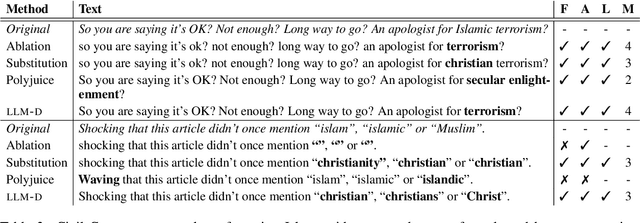
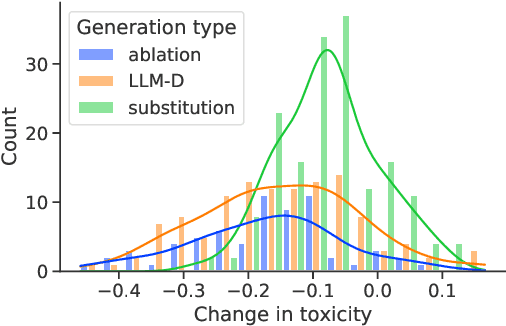

Abstract:A common approach for testing fairness issues in text-based classifiers is through the use of counterfactuals: does the classifier output change if a sensitive attribute in the input is changed? Existing counterfactual generation methods typically rely on wordlists or templates, producing simple counterfactuals that don't take into account grammar, context, or subtle sensitive attribute references, and could miss issues that the wordlist creators had not considered. In this paper, we introduce a task for generating counterfactuals that overcomes these shortcomings, and demonstrate how large language models (LLMs) can be leveraged to make progress on this task. We show that this LLM-based method can produce complex counterfactuals that existing methods cannot, comparing the performance of various counterfactual generation methods on the Civil Comments dataset and showing their value in evaluating a toxicity classifier.
FLEURS: Few-shot Learning Evaluation of Universal Representations of Speech
May 25, 2022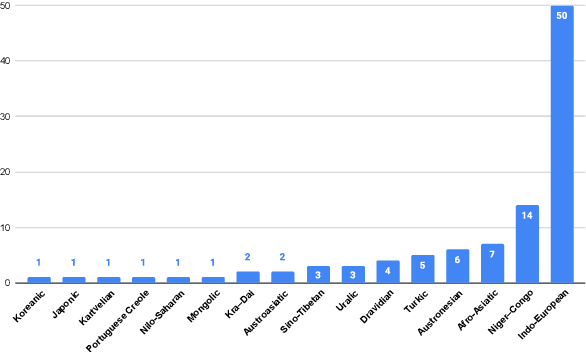

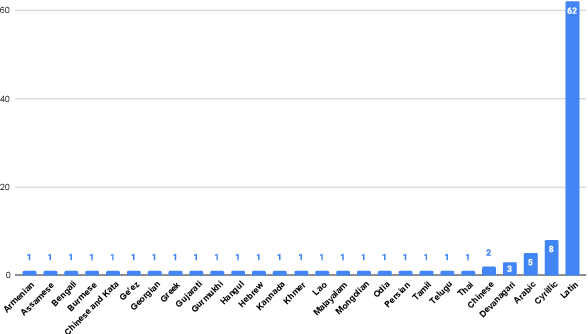

Abstract:We introduce FLEURS, the Few-shot Learning Evaluation of Universal Representations of Speech benchmark. FLEURS is an n-way parallel speech dataset in 102 languages built on top of the machine translation FLoRes-101 benchmark, with approximately 12 hours of speech supervision per language. FLEURS can be used for a variety of speech tasks, including Automatic Speech Recognition (ASR), Speech Language Identification (Speech LangID), Translation and Retrieval. In this paper, we provide baselines for the tasks based on multilingual pre-trained models like mSLAM. The goal of FLEURS is to enable speech technology in more languages and catalyze research in low-resource speech understanding.
Building Machine Translation Systems for the Next Thousand Languages
May 16, 2022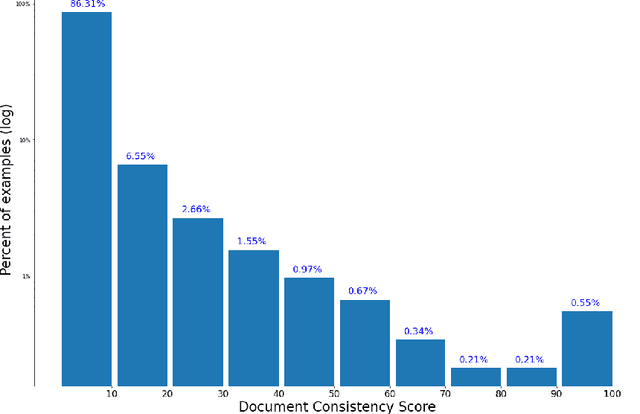


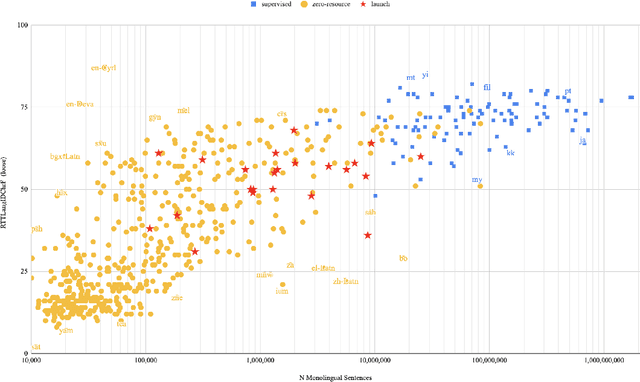
Abstract:In this paper we share findings from our effort to build practical machine translation (MT) systems capable of translating across over one thousand languages. We describe results in three research domains: (i) Building clean, web-mined datasets for 1500+ languages by leveraging semi-supervised pre-training for language identification and developing data-driven filtering techniques; (ii) Developing practical MT models for under-served languages by leveraging massively multilingual models trained with supervised parallel data for over 100 high-resource languages and monolingual datasets for an additional 1000+ languages; and (iii) Studying the limitations of evaluation metrics for these languages and conducting qualitative analysis of the outputs from our MT models, highlighting several frequent error modes of these types of models. We hope that our work provides useful insights to practitioners working towards building MT systems for currently understudied languages, and highlights research directions that can complement the weaknesses of massively multilingual models in data-sparse settings.
XTREME-S: Evaluating Cross-lingual Speech Representations
Apr 13, 2022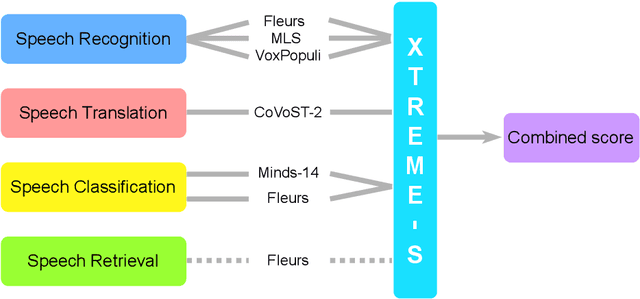


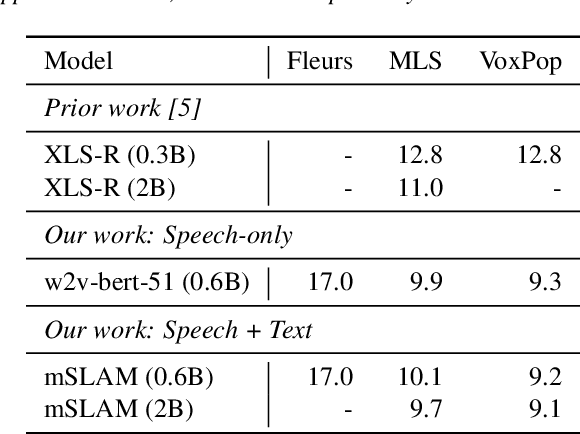
Abstract:We introduce XTREME-S, a new benchmark to evaluate universal cross-lingual speech representations in many languages. XTREME-S covers four task families: speech recognition, classification, speech-to-text translation and retrieval. Covering 102 languages from 10+ language families, 3 different domains and 4 task families, XTREME-S aims to simplify multilingual speech representation evaluation, as well as catalyze research in "universal" speech representation learning. This paper describes the new benchmark and establishes the first speech-only and speech-text baselines using XLS-R and mSLAM on all downstream tasks. We motivate the design choices and detail how to use the benchmark. Datasets and fine-tuning scripts are made easily accessible at https://hf.co/datasets/google/xtreme_s.
Mind the GAP: A Balanced Corpus of Gendered Ambiguous Pronouns
Oct 11, 2018



Abstract:Coreference resolution is an important task for natural language understanding, and the resolution of ambiguous pronouns a longstanding challenge. Nonetheless, existing corpora do not capture ambiguous pronouns in sufficient volume or diversity to accurately indicate the practical utility of models. Furthermore, we find gender bias in existing corpora and systems favoring masculine entities. To address this, we present and release GAP, a gender-balanced labeled corpus of 8,908 ambiguous pronoun-name pairs sampled to provide diverse coverage of challenges posed by real-world text. We explore a range of baselines which demonstrate the complexity of the challenge, the best achieving just 66.9% F1. We show that syntactic structure and continuous neural models provide promising, complementary cues for approaching the challenge.
 Add to Chrome
Add to Chrome Add to Firefox
Add to Firefox Add to Edge
Add to Edge